
®
Auto-Darkening Helmets
Model: Infinity Series w/Infotrackt
OM-269 681A
2015−03
To help us serve you better, go to www.MillerWelds.Com/Register

TABLE OF CONTENTS
SECTION 1 − WELDING HELMET SAFETY PRECAUTIONS −READ BEFORE USING 1......
1-1. Symbol Usage 1............................................................
1-2. Arc Welding Hazards 1.......................................................
1-3. Proposition 65 Warnings 3....................................................
1-4. Lens Shade Selection Table 3.................................................
1-5. Principal Safety Standards 3..................................................
SECTION 2 − SPECIFICATIONS 5.....................................................
SECTION 3 − OPERATING INSTRUCTIONS 6..........................................
3-1. Helmet Controls 6...........................................................
3-2. Auto On/Off Button And Grind Mode/Low Battery Light 7...........................
3-3. Mode Control Button 8.......................................................
3-4. Variable Shade Control 9.....................................................
3-5. Lens Delay Control 10.........................................................
3-6. Sensitivity Control 11..........................................................
3-7. Typical Lens Adjustment Procedure 12...........................................
3-8. Info Control Button 13.........................................................
3-9. Arc Time Control 14...........................................................
3-10. Clock Control 15.............................................................
3-11. Timer Control 16.............................................................
3-12. Alarm Control 17.............................................................
3-13. Setting Help Menu Language And Viewing Help Menu 18...........................
SECTION 4 − ADJUSTING HEADGEAR 19.............................................
4-1. Adjusting Headgear 19........................................................
SECTION 5 − REPLACING THE GRINDING SHIELD OR LENS COVERS 20................
5-1. Replacing Lens Covers 20.....................................................
SECTION 6 − REPLACING THE BATTERY (AUTO-DARKENING LENS ASSEMBLIES) 21....
6-1. Replacing The Batteries 21.....................................................
SECTION 7 − INSTALLING OPTIONAL MAGNIFYING LENS 22...........................
SECTION 8 − MAINTENANCE 22.....................................................
SECTION 9 − TROUBLESHOOTING 23................................................
SECTION 10 − PARTS LIST 24.......................................................
SECTION 11 − LIMITED WARRANTY 25...............................................
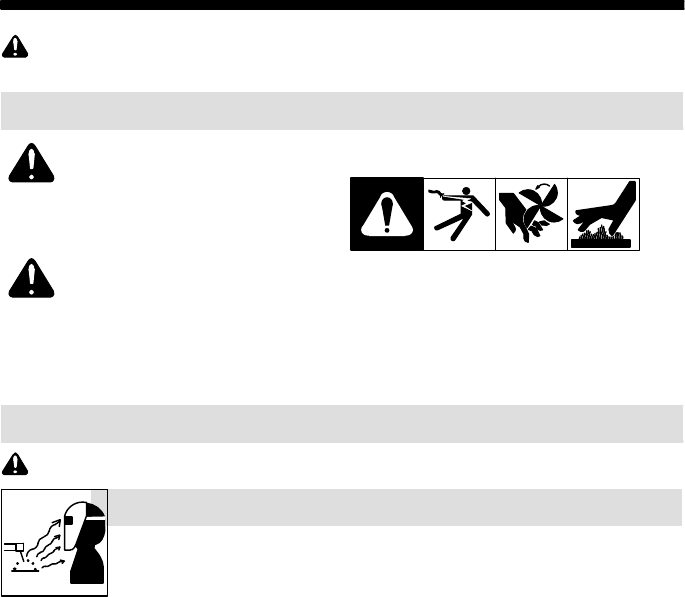
OM-269 681 Page 1
SECTION 1 − WELDING HELMET SAFETY PRECAUTIONS −
READ BEFORE USING
helmet 2013-09
Protect yourself and others from injury — read, follow, and save these important safety
precautions and operating instructions.
1-1. Symbol Usage
This group of symbols means Warning! Watch
Out! ELECTRIC SHOCK, MOVING PARTS,
and HOT PARTS hazards. Consult symbols
and related instructions below for necessary
actions to avoid the hazards.
Indicates special instructions.
DANGER! − Indicates a hazardous
situation which, if not avoided, will
result in death or serious injury. The
possible hazards are shown in the
adjoining symbols or explained in
the text.
Indicates a hazardous situation
which, if not avoided, could result in
death or serious injury. The possible
hazards are shown in the adjoining
symbols or explained in the text.
NOTICE − Indicates statements not related to
personal injury.
1-2. Arc Welding Hazards
Only qualified persons should install, operate, maintain, and repair this unit.
Arc rays from the welding process produce intense visible and invisible (ultravio-
let and infrared) rays that can burn eyes and skin. Sparks fly off from the weld.
Wear a welding helmet fitted with a proper shade of filter to protect your face and eyes when
welding or watching (see ANSI Z49.1 and Z87.1 listed in Safety Standards). Refer to Lens
Shade Selection table in Section 1-4.
Wear approved safety glasses with side shields under your helmet.
Use protective screens or barriers to protect others from flash, glare, and sparks; warn
others not to watch the arc.
Wear body protection made from durable, flame−resistant material (leather, heavy cotton,
wool). Body protection includes oil-free clothing such as leather gloves, heavy shirt, cuffless
trousers, high shoes, and a cap.
• Before welding, adjust the auto-darkening lens sensitivity setting to meet the application.
• Stop welding immediately if the auto-darkening lens does not darken when the arc is struck.
See the Owner’s Manual for more information.
ARC RAYS can burn eyes and skin.
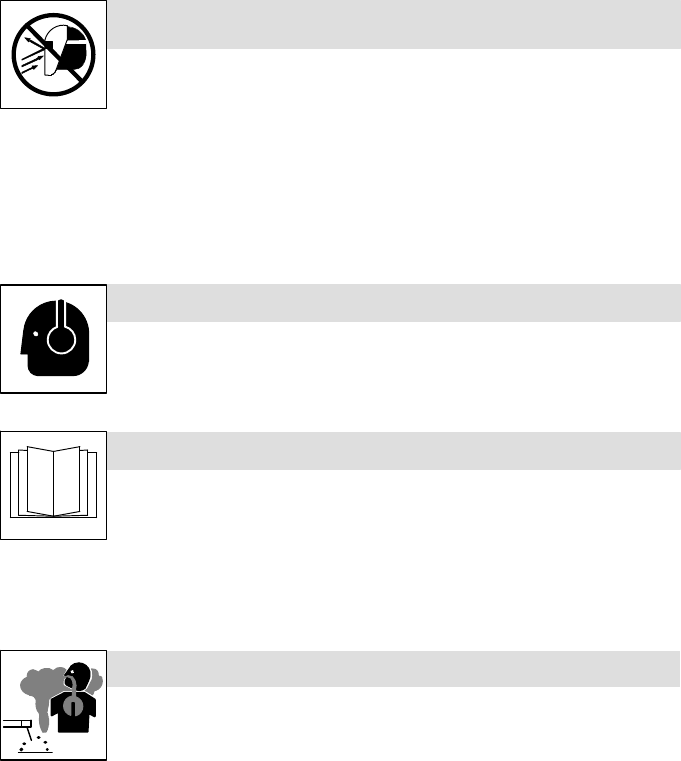
OM-269 681 Page 2
WELDING HELMETS do not provide unlimited eye, ear, and
face protection.
Arc rays from the welding process produce intense visible and invisible (ultraviolet
and infrared) rays that can burn eyes and skin. Sparks fly off from the weld.
Use impact resistant safety spectacles or goggles and ear protection at all times when using
this welding helmet.
Do not use this helmet while working with or around explosives or corrosive liquids.
Do not weld in the overhead position while using this helmet.
Inspect the auto-lens frequently. Immediately replace any scratched, cracked, or pitted cover
lenses or auto-lenses.
NOISE can damage hearing.
Noise from some processes or equipment can damage hearing.
Wear approved ear protection if noise level is high.
READ INSTRUCTIONS.
Read and follow all labels and the Owner’s Manual carefully before in-
stalling, operating, or servicing unit. Read the safety information at the be-
ginning of the manual and in each section.
Use only genuine replacement parts from the manufacturer.
Perform maintenance and service according to the Owner’s Manuals, industry standards,
and national, state, and local codes.
FUMES AND GASES can be hazardous.
Welding produces fumes and gases. Breathing these fumes and gases can be
hazardous to your health.
Keep your head out of the fumes. Do not breathe the fumes.
If inside, ventilate the area and/or use local forced ventilation at the arc to remove welding
fumes and gases. The recommended way to determine adequate ventilation is to sample for
the composition and quantity of fumes and gases to which personnel are exposed.
If ventilation is poor, wear an approved air-supplied respirator.
Read and understand the Safety Data Sheets (SDSs) and the manufacturer’s instructions for
adhesives, coatings, cleaners, consumables, coolants, degreasers, fluxes, and metals.
Work in a confined space only if it is well ventilated, or while wearing an air-supplied respirator.
Always have a trained watchperson nearby. Welding fumes and gases can displace air and
lower the oxygen level causing injury or death. Be sure the breathing air is safe.
Do not weld in locations near degreasing, cleaning, or spraying operations. The heat and rays
of the arc can react with vapors to form highly toxic and irritating gases.
Do not weld on coated metals, such as galvanized, lead, or cadmium plated steel, unless the
coating is removed from the weld area, the area is well ventilated, and while wearing an air-
supplied respirator. The coatings and any metals containing these elements can give off toxic
fumes if welded.
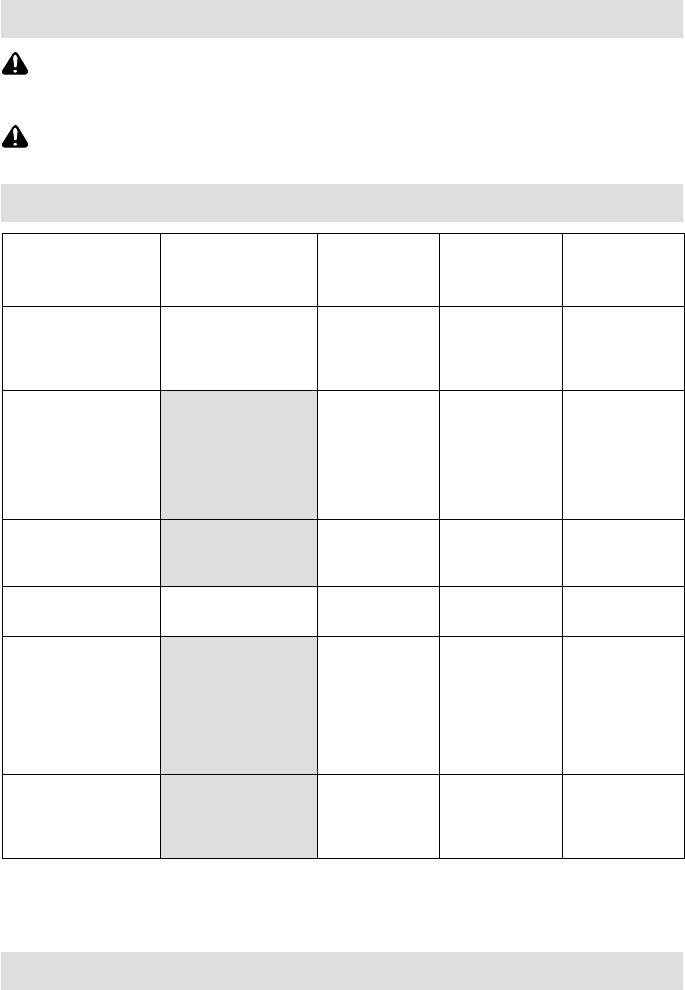
OM-269 681 Page 3
1-3. Proposition 65 Warnings
Welding or cutting equipment produces fumes or gases which contain chemicals known
to the State of California to cause birth defects and, in some cases, cancer. (California
Health & Safety Code Section 25249.5 et seq.)
This product contains chemicals, including lead, known to the state of California to cause
cancer, birth defects, or other reproductive harm. Wash hands after use.
1-4. Lens Shade Selection Table
Process
Electrode Size
in. (mm)
Arc Current
in
Amperes
Minimum
Protective
Shade No.
Suggested
Shade No.
(Comfort)*
Shielded Metal Arc
Welding (SMAW)
Less than 3/32 (2.4)
3/32−5/32 (2.4−4.0)
5/32−1/4 (4.0−6.4)
More than 1/4 (6.4)
Less than 60
60−160
160−250
250−550
7
8
10
11
−−
10
12
14
Gas Metal
Arc Welding
(GMAW)
Flux Cored
Arc Welding
(FCAW)
Less than 60
60−160
160−250
250−500
7
10
10
10
−−
11
12
14
Gas Tungsten Arc
Welding (TIG)
Less than 50
50−150
150−500
8
8
10
10
12
14
Air Carbon
Arc Cutting (CAC-A)
Light
Heavy
Less than 500
500−1000
10
11
12
14
Plasma Arc
Cutting (PAC)
Less than 20
20−40
40−60
60−80
80−300
300−400
400−800
4
5
6
8
8
9
10
4
5
6
8
9
12
14
Plasma Arc Welding
(PAW)
Less than 20
20−100
100−400
400−800
6
8
10
11
6−8
10
12
14
Reference: ANSI Z49.1:2005
* Start with a shade that is too dark to see the weld zone. Then, go to a lighter shade which gives a
sufficient view of the weld zone without going below the minimum.
1-5. Principal Safety Standards
Safety in Welding, Cutting, and Allied Processes, ANSI Standard Z49.1, is available as a free down-
load from the American Welding Society at http://www.aws.org or purchased from Global Engineering
Documents (phone: 1-877-413-5184, website: www.global.ihs.com).
Safe Practice For Occupational And Educational Eye And Face Protection, ANSI Standard Z87.1,
from American National Standards Institute, 25 West 43rd Street, New York, NY 10036 (phone:
212-642-4900, website: www.ansi.org).

OM-269 681 Page 4
Notes

OM-269 681 Page 5
SECTION 2 − SPECIFICATIONS
Specification Digital Infinity Helmet
Viewing Field 4.4 x 3.1 in
(112 x 78 mm)
Reaction Time 0.0000500 sec (1/20,000)
Available Shades
All Shades Provide Continuous
UV And IR Protection.
Weld Mode
Darkened State: No. 8 − No. 13
Light State: No. 3
Cut Mode
Darkened State: No. 5 − No. 8
Light State: No. 3
Grind Mode
Light State: No. 3
X-Mode
Darkened State: No. 8 − No. 13
Light State: No. 3
Sensitivity Control Adjustable For Varying Ambient Light And Welding Arc
Delay Control Slows Lens Dark-To-Light State Between 0.1 And 1.0
Seconds
Automatic Power Off Shuts Lens Off 45 Minutes After Last Arc Is Struck
Low Battery Light Red Led Illuminates To Indicate 2−3 Days Remaining Battery
Life
Power Supply CR2450 Lithium Batteries
(Miller Part No. 217 043)
Sensors Independent/Redundant (Four)
Operating Temperature 14F to 131F / −10C to +55C
When Stored In Extremely Cold Temperatures, Warm Hel-
met To Ambient Temperature Before Welding.
Storage Temperature −4F to 158F / −20C to +70C
When Stored In Extremely Cold Temperatures, Warm Hel-
met To Ambient Temperature Before Welding.
Total Weight 23 oz (650 g)
Standards ANSI Z87.1+(2010) and CSA
Warranty Three Years From Date Of Purchase (Section 11)
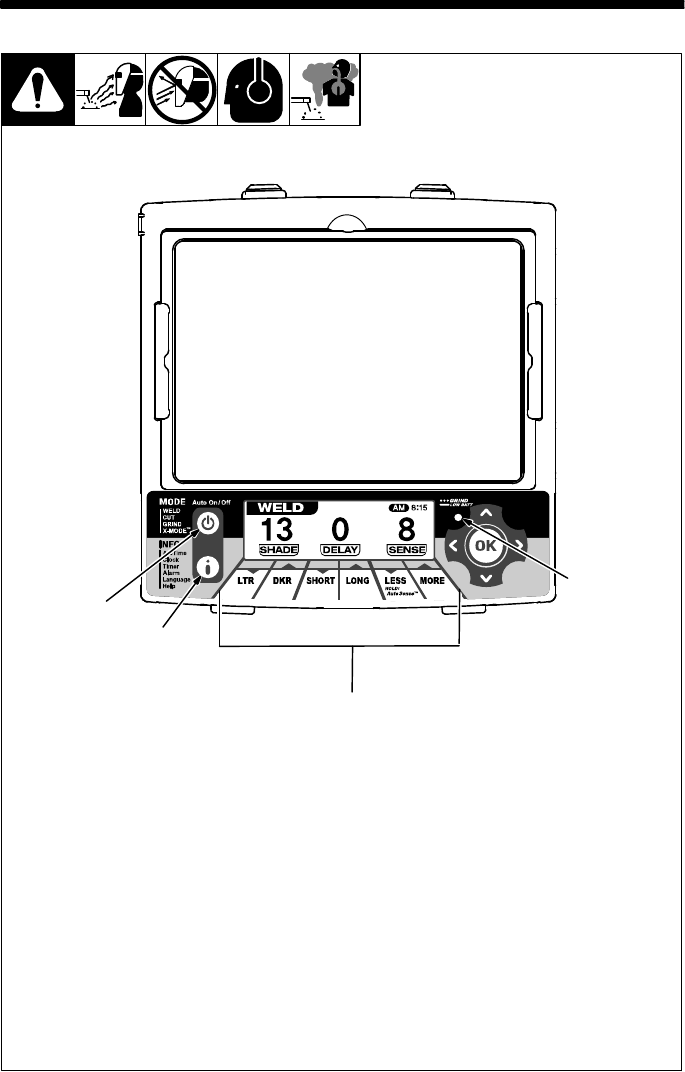
OM-269 681 Page 6
SECTION 3 − OPERATING INSTRUCTIONS
3-1. Helmet Controls
The auto-darkening lens
turns on (darkens) automati-
cally when welding begins
and turns off when welding
stops.
1 Auto On/Off Button
(See Section 3-2)
Mode Control Button
(Section 3-3)
2 Grind Mode/Low
Battery Light (Section
3-2)
3 Lens/Info Adjustment
Buttons (See Sections
3-4 Through 3-6)
Use adjustment buttons
to change shade, delay,
and sensitivity settings
when lens is in Mode
function. Use adjust-
ment buttons to change
arc time, clock, timer,
alarm, language, and
help settings when lens
is in Info function.
4 Info Control Button
(See Section 3-8)
The lens assembly
saves the shade, sensi-
tivity, and delay settings.
1
3
4
2
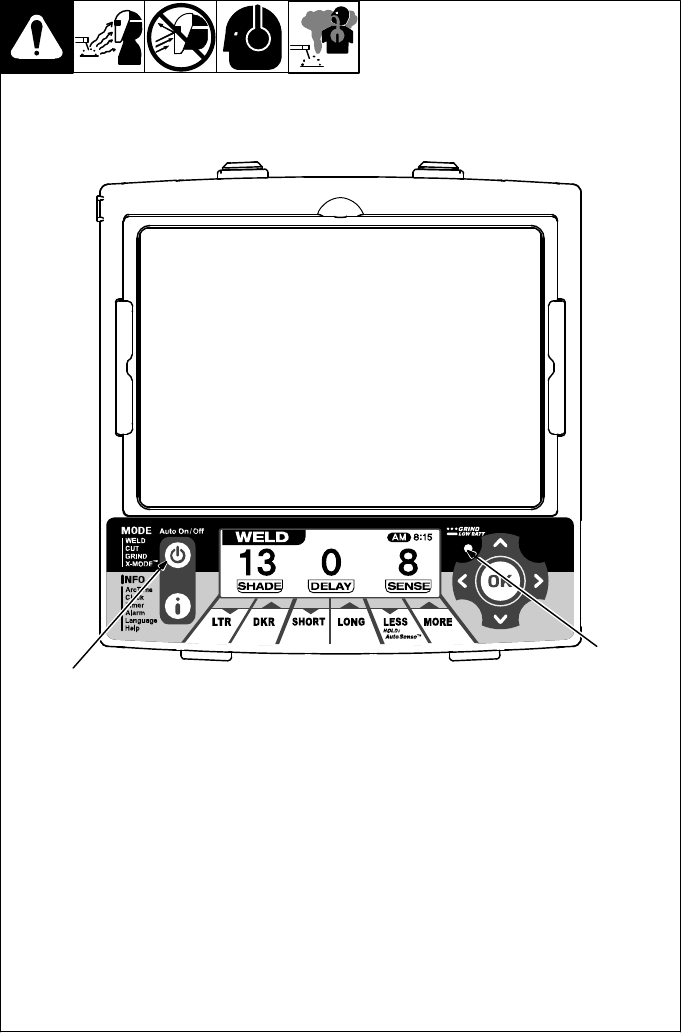
OM-269 681 Page 7
3-2. Auto On/Off Button And Grind Mode/Low Battery Light
The auto-darkening lens
turns on (darkens) auto-
matically when welding
begins and turns off
when welding stops.
1 Auto On/Off Button
Press Auto On/Off button to
check if the lens is working
properly and to begin Mode
and Info adjustments.
When the Auto On/Off button
is pressed, the LCD control
panel will turn On.
Press and hold the Auto On/
Off button to turn the LCD
control panel Off. Lens is on
and will function properly.
After four minutes of in-
activity, the LCD control
panel will turn off auto-
matically to conserve
power. Press any button
to wake up the LCD con-
trol panel.
2 Grind/Low Battery Light
The Grind/Low Battery light
blinks when the lens is in the
Grind mode. Light stays on
when 2−3 days of battery life
remain.
If battery power is low, re-
place with CR2450 lithium
batteries (2 required − Miller
Part No. 217 043). See Sec-
tion 6.
1
2
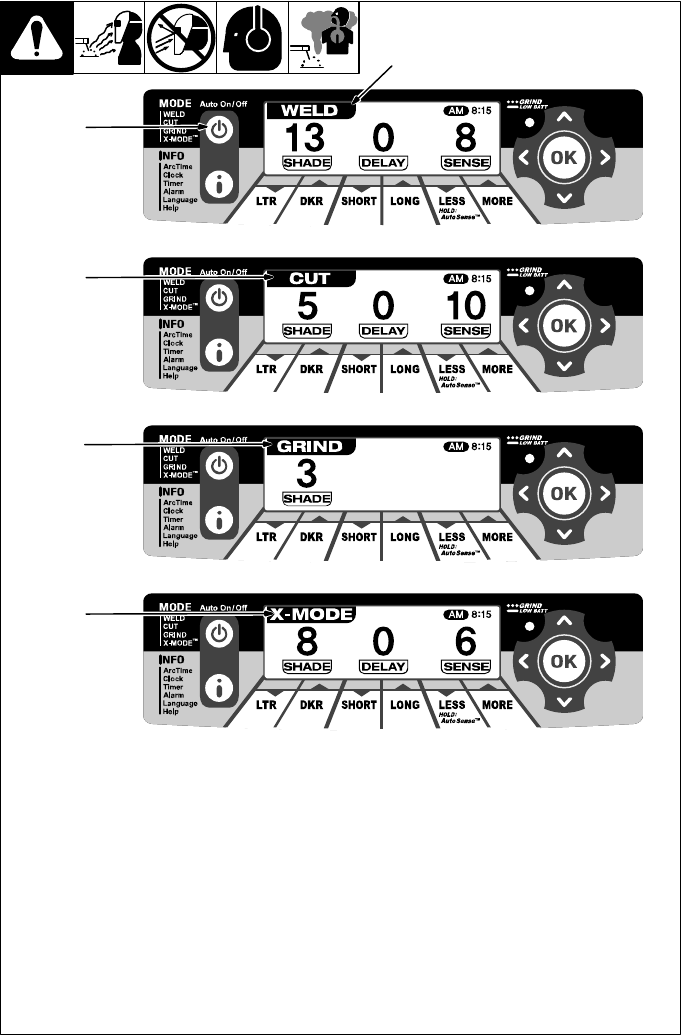
OM-269 681 Page 8
3-3. Mode Control Button
1 Mode Control Button
Press Mode button to select
the mode appropriate for the
work activity.
2 Weld Mode
Used for most welding
applications. In this mode
the lens turns on when it
optically senses a welding
arc. Adjust shade,
sensitivity, and delay
settings as needed.
3 Cut Mode
Used for cutting applica-
tions. In this mode the lens
turns on when it optically
senses a cutting arc. Adjust
shade, sensitivity, and delay
settings as needed.
4 Grind Mode
Used for metal grinding ap-
plications. In this mode the
lens is fixed at shade No. 3.
No lens adjustments are
possible.
5 X-Mode
Used for outdoor or low cur-
rent welding applications. In
this mode the lens turns on
when it senses a welding
arc. Adjust shade, sensitiv-
ity, and delay settings as
needed.
Nearby welding may af-
fect helmet operation
when lens is in X-Mode.
Stay at least 12 ft
(3.7 m) away from other
welding activity.
1
2
3
4
5
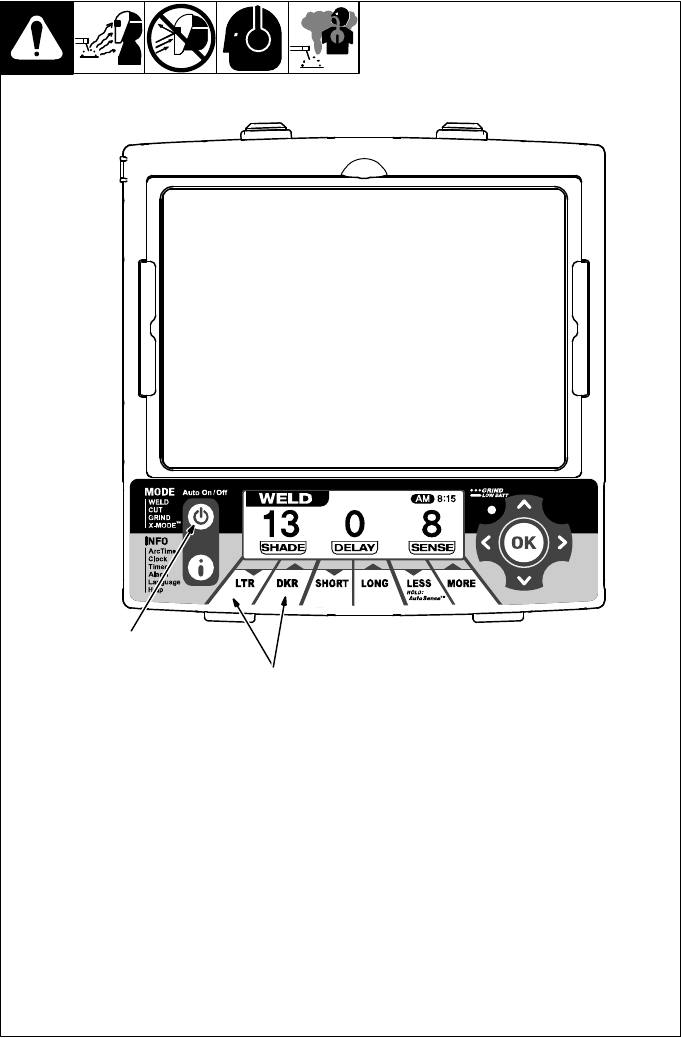
OM-269 681 Page 9
3-4. Variable Shade Control
1 Variable Shade
Adjustment Buttons
2 Mode Control Button
Use the LTR and DKR ad-
justment buttons to adjust
the lens shade in the dark-
ened state. Use the table in
Section 1-4 to select proper
shade control setting based
on your welding process.
The shade ranges for each
mode are as follows:
Weld − No. 8 − No. 13
Cut − No. 5 − No. 8
Grind − No. 3 only
X Mode − No. 8 − No. 13
Start at the highest setting
and adjust lighter to suit the
application and your person-
al preference.
Variable Shade Adjust-
ment Procedure
Press Auto On/Off but-
ton to turn lens On.
Press Mode Control
Button to select desired
function: Weld, Cut, or
X-Mode.
Use LTR and DKR ad-
justment buttons to se-
lect desired shade.
Begin welding or contin-
ue with other lens ad-
justments.
1
2
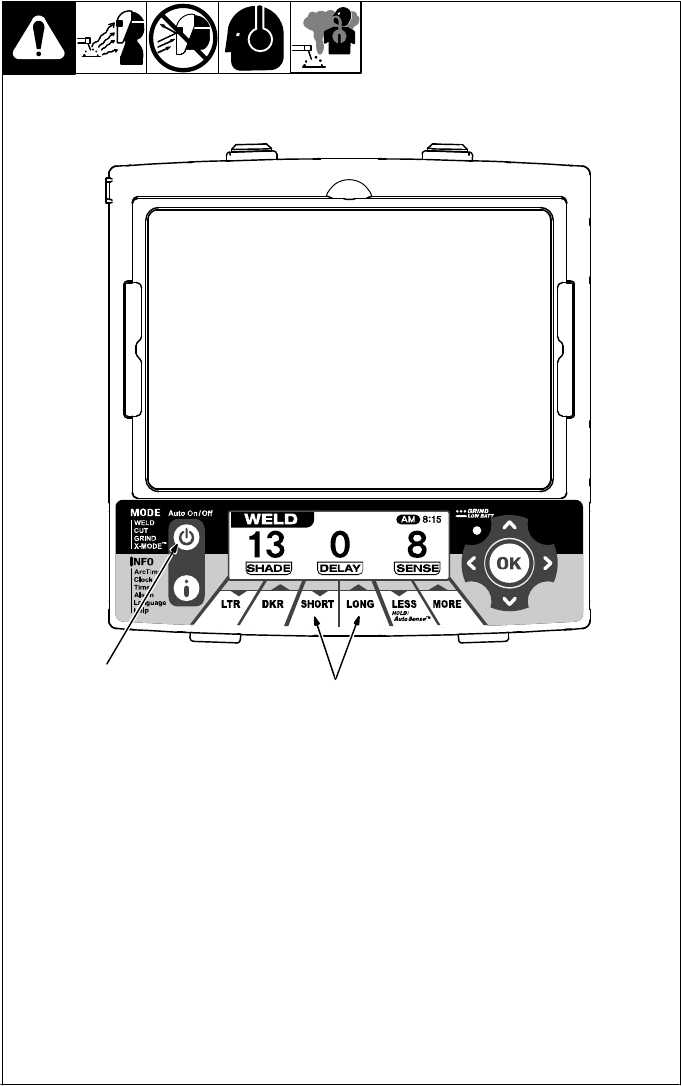
OM-269 681 Page 10
3-5. Lens Delay Control
1
1 Lens Delay Adjustment
Buttons
2 Mode Control Button
Use the Lens Delay Short
and Long buttons to adjust
the time for the lens to switch
to the clear state after weld-
ing or cutting.
The delay is particularly use-
ful in eliminating bright af-
ter-rays present in higher
amperage applications
where the molten puddle re-
mains bright momentarily af-
ter welding. Use the Lens De-
lay Control buttons to adjust
delay from 0 to 10 (0.1 to 1.0
second).
The delay ranges for each
mode are as follows:
Weld, Cut, X-Modes −
0 − 10
Grind Mode − No delay ad-
justment
There is no lens delay
adjustment in the Grind
mode.
Lens Delay Adjustment
Procedure
Press Auto On/Off but-
ton to turn helmet On.
Press Mode button to se-
lect desired function:
Weld, Cut, or X-Mode.
Use Short and Long ad-
justment buttons to se-
lect desired delay.
Begin welding or contin-
ue with other lens adjust-
ments.
2

OM-269 681 Page 11
3-6. Sensitivity Control
1 Sensitivity Adjustment
Buttons
2 Mode Control Button
Use control to make the lens
more responsive to different
light levels in various welding
processes. Use a Mid-
Range or 30−50% sensitiv-
ity setting for most
applications.
It may be necessary to adjust
helmet sensitivity to accom-
modate different lighting
conditions or if lens is flashing
On and Off.
The sensitivity ranges for
each mode are as follows:
Weld, Cut, X-Modes − 0 − 10
Grind Mode − No sensitivity
adjustment
! Do not weld in the
Grind mode. The lens
will not darken.
Sensitivity Adjustment
Procedure
Adjust helmet sensitivity
in lighting conditions hel-
met will be used in.
Press Auto On/Off button
to turn helmet On.
Press Mode button to se-
lect desired function:
Weld, Cut, or X-Mode.
Use Sensitivity Less and
More buttons to adjust
sensitivity control to low-
est setting.
Face helmet in the direc-
tion of use, exposing it to
the surrounding light con-
ditions.
Press Sensitivity More
button until the lens dark-
ens, then press Less
button until lens clears.
An alternative method is
to press and hold the
Less button until the lens
clears.
Helmet is ready for use. Slight
readjustment may be neces-
sary for certain applications
or if lens is flashing on and off.
Reduce Sensitivity set-
ting if lens stays dark
longer than Delay set-
ting.
This lens also features
AutoSense, which allows
users to push and hold only
one button for the lens to ad-
just sensitivity to the proper
setting while in Weld mode.
To initiate AutoSense,
face helmet toward
workpiece and push and
hold the Less/AutoSense
button until screen indi-
cates that it is adjusting.
Lens will then set to cur-
rent lighting conditions
and can be fine tuned for
preference.
1
2
Recommended Sensitivity Settings
Stick Electrode Mid-Range
Short Circuiting (MIG) Low/Mid-Range
Pulsed & Spray (MIG) Mid-Range
Gas Tungsten Arc (TIG) Mid/High-Range
Plasma Arc Cutting/Welding Low/Mid-Range
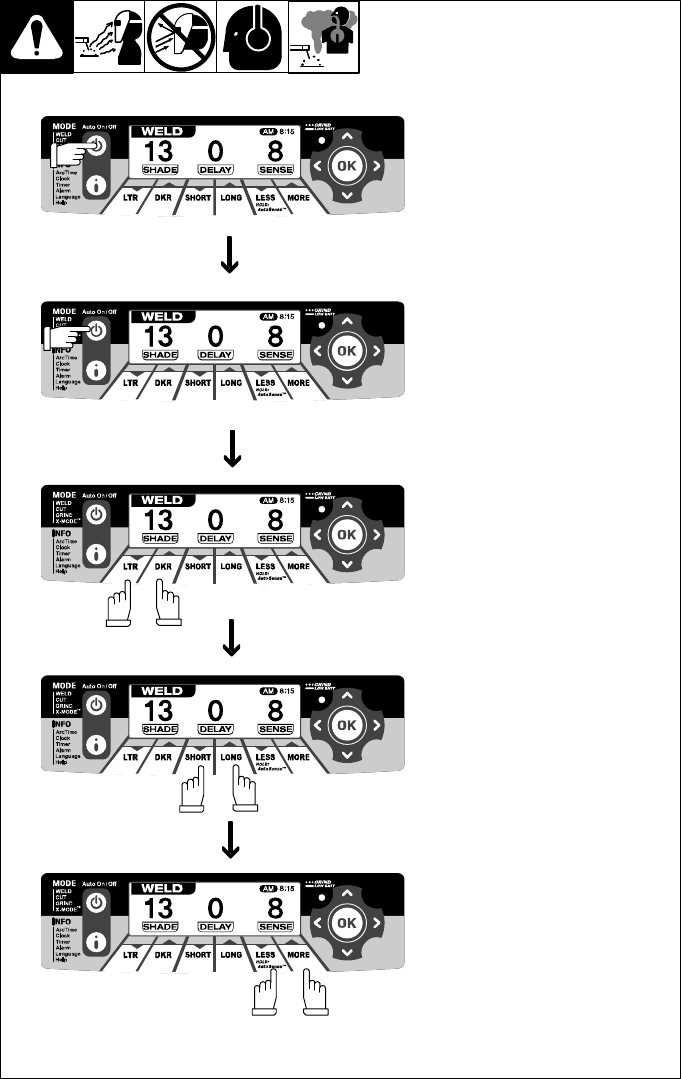
OM-269 681 Page 12
3-7. Typical Lens Adjustment Procedure
Lens assembly displays prior
settings when turned On. Re-
tained settings are not shown
in example.
In the Grind mode the lens is a
fixed shade No. 3. No lens ad-
justments are possible.
Adjusting Lens Assembly:
Turn lens On. Display screen
appears.
Select mode (Weld, Cut, Grind,
X-Mode).
Select shade by pressing LTR
and DKR buttons.
Select Delay by pressing Short
and Long buttons.
Select Sensitivity by pressing
Less and More Buttons.
Begin work.
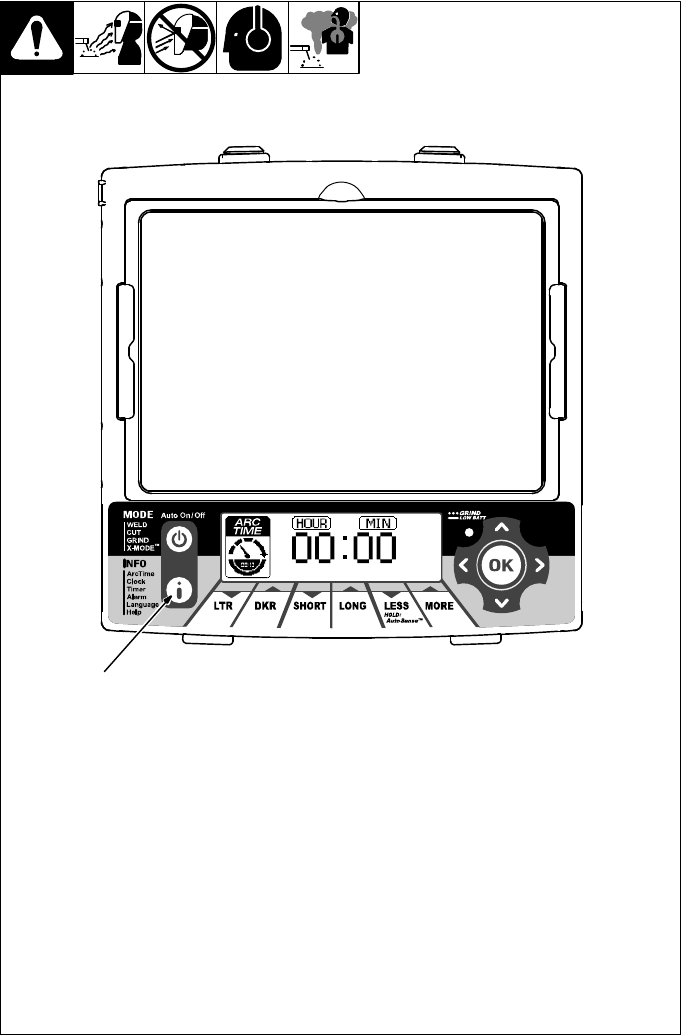
OM-269 681 Page 13
3-8. Info Control Button
1 Info Control Button
Press Info Control button to
select from the following
functions:
Arc Time − Records the
amount of time the lens as-
sembly is in the dark state
(exposed to arc). See Sec-
tion 3-9 to reset Arc Time.
Clock − Displays actual
time of day. See Section
3-10 to set clock.
Timer − Emits an audible
signal and flashes the
Grind mode light to alert the
operator after a specific
period of time has elapsed.
See Section 3-11 to set
timer.
Alarm − Emits an audible
signal and flashes the
Grind mode light to alert the
operator at a specific time.
See Section 3-12 to set
alarm.
Language − Sets lan-
guage for the Help menu.
See Section 3-13 to set lan-
guage.
Help − Displays Help top-
ics. See Section 3-13.
Lens automatically
exits the Info function
after one minute of in-
activity.
1
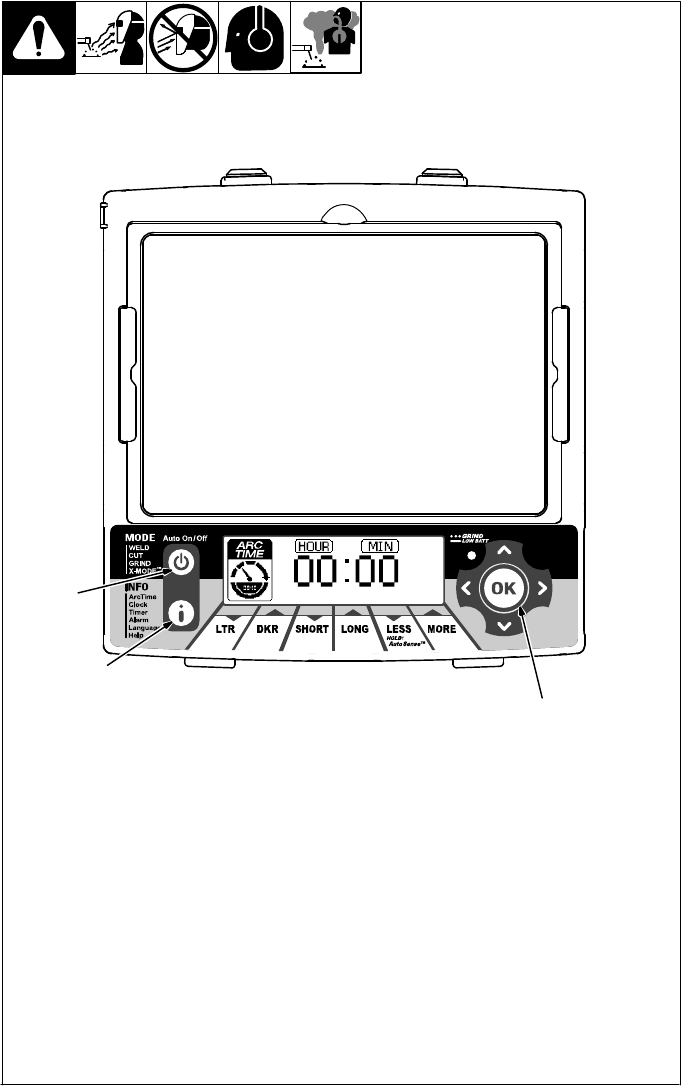
OM-269 681 Page 14
3-9. Arc Time Control
The arc time function re-
cords the amount of time the
lens assembly is dark (ex-
posed to an arc).
1 Info Control Button
2 OK Button
3 Auto On/Off Button
Arc Time Procedure
Press Auto On/Off but-
ton to turn helmet On.
Press Info Control but-
ton repeatedly until Arc
Time is displayed on
screen.
Press OK button to
clear the arc time to
zero.
Press Auto On/Off but-
ton when finished.
Arc time is accumulat-
ed by the second, but
only hours and minutes
are displayed.
1
2
3
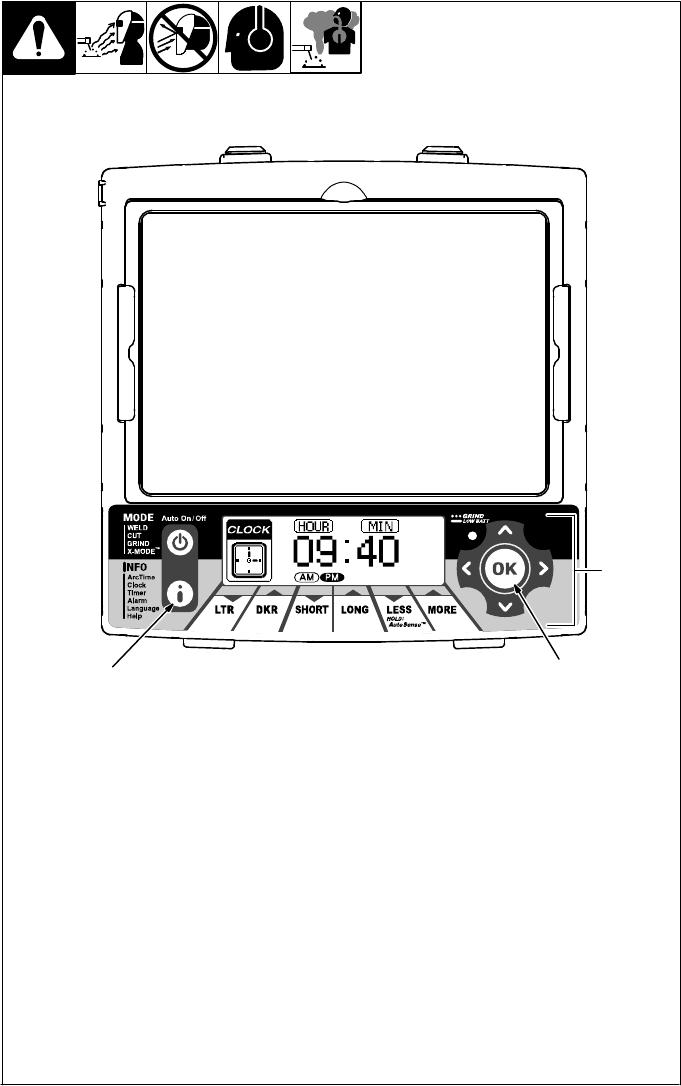
OM-269 681 Page 15
3-10. Clock Control
1
The clock displays the actual
time of day.
1 Info Control Button
2 Directional Buttons
3 OK Button
Clock Procedure
Press Auto On/Off but-
ton to turn helmet On.
Press Info button re-
peatedly until Clock is
displayed on screen.
Use left/right arrows to
select hour or minute for
adjustment.
Adjust the hours to
change between a.m.
and p.m.
Use up/down arrows to
adjust to proper time.
Press OK to save.
Press Auto On/Off but-
ton when finished.
2
3
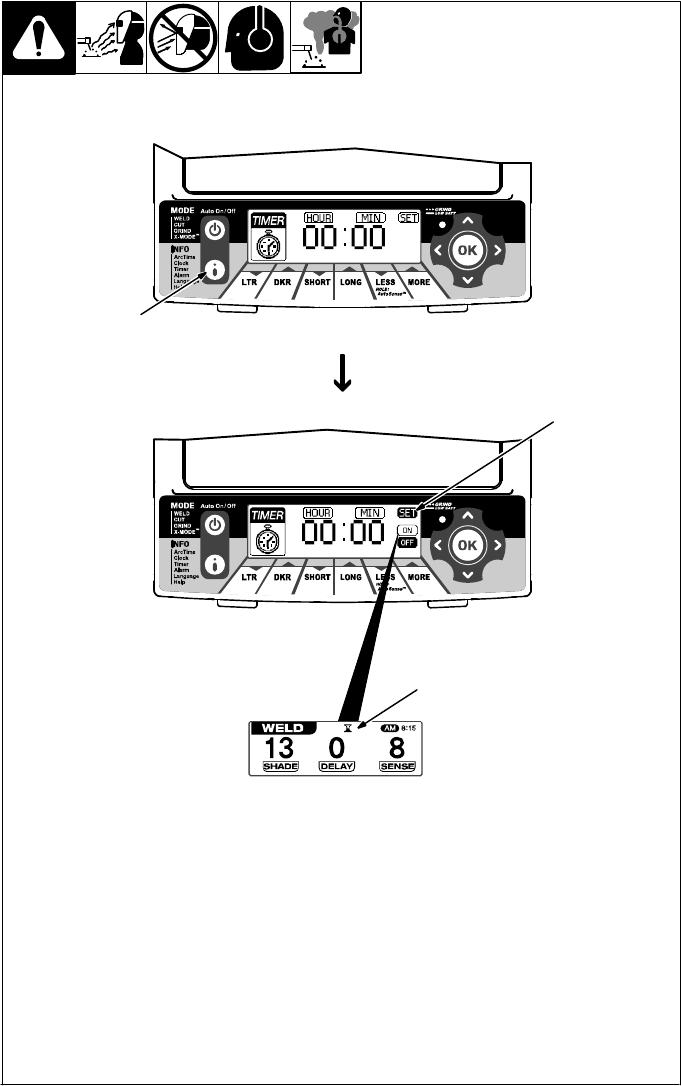
OM-269 681 Page 16
3-11. Timer Control
The Timer emits an audible
signal and flashes the Grind
mode light to alert the operat-
or after a specific period of
time has elapsed.
1 Info Control Button
Timer Procedure
Press Auto On/Off but-
ton to turn helmet On.
Press Info Control but-
ton repeatedly until
Timer is displayed on
screen.
Use left/right arrows to
select hour or minute for
adjustment.
Use up/down arrows to
adjust to desired time.
2 Set Selection
3 Timer On Indicator
Use left/right arrows to
select Set. Use up/down
arrows to turn timer On/
Off.
Times can be saved for
future use, but the timer
must be turned on to be
active.
Press the OK button to
save, or press the Auto
On/Off button to exit.
Press any lens button to
turn off alarm.
1
2
3

OM-269 681 Page 17
3-12. Alarm Control
The Alarm emits an audible
signal and flashes the Grind
mode light to alert the operat-
or at a specific time.
1 Info Control Button
Alarm Procedure
Press Auto On/Off but-
ton to turn helmet On.
Press Info button re-
peatedly until Alarm is
displayed on screen.
Press left/right arrows to
select hour or minutes
for adjustment
Use up/down arrows to
adjust to desired time.
2 Set Selection
3 Alarm On Indicator
Use left/right arrows to
select Set. Use up/down
arrows to turn Alarm On/
Off.
Press the OK button to
save, or press the Auto
On/Off button to exit.
Press any lens button to
turn off alarm.
1
2
3
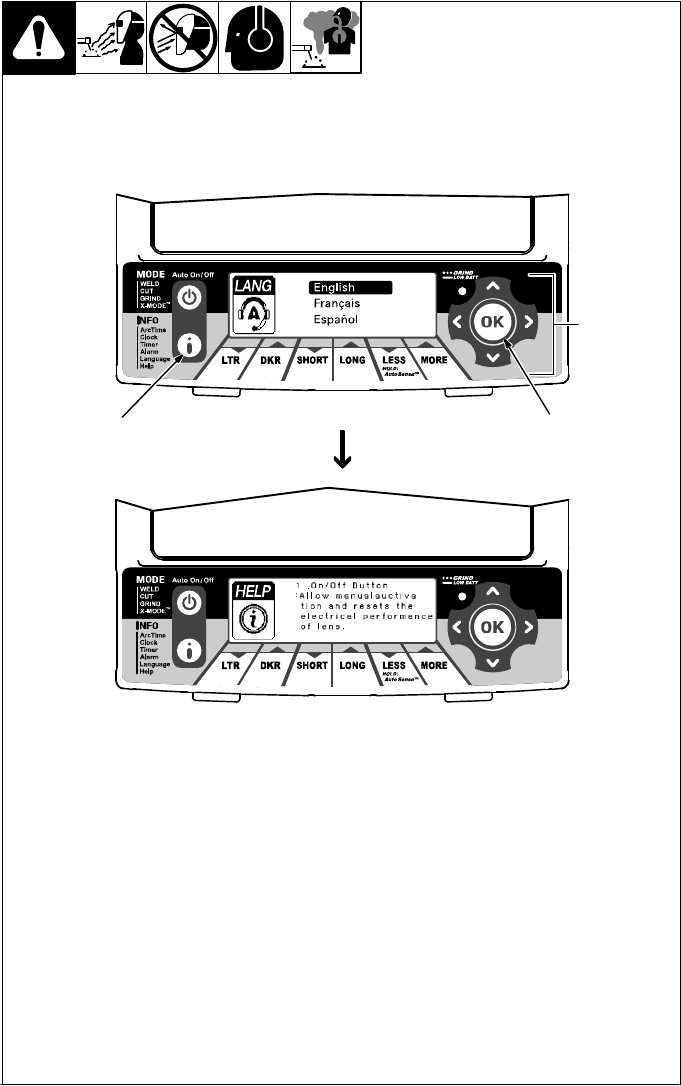
OM-269 681 Page 18
3-13. Setting Help Menu Language And Viewing Help Menu
1 Info Control Button
2 Directional Buttons
3 OK Button
Press Auto On/Offf but-
ton to turn helmet on.
Press Info button re-
peatedly until Language
is displayed on screen.
Use up/down arrows to
select desired lan-
guage. Press OK to
save.
Press the Info Control
button once. Help menu
will now be shown in the
desired language.
To navigate the Help
menu, use either the up/
down arrows or the left/
right arrows. To exit,
press the Auto On/Off
button.
Help menu displays ab-
breviated instructions,
modes, and notes on
proper usage. Help
menu should not be
used as a replacement
for the full manual.
1
2
3
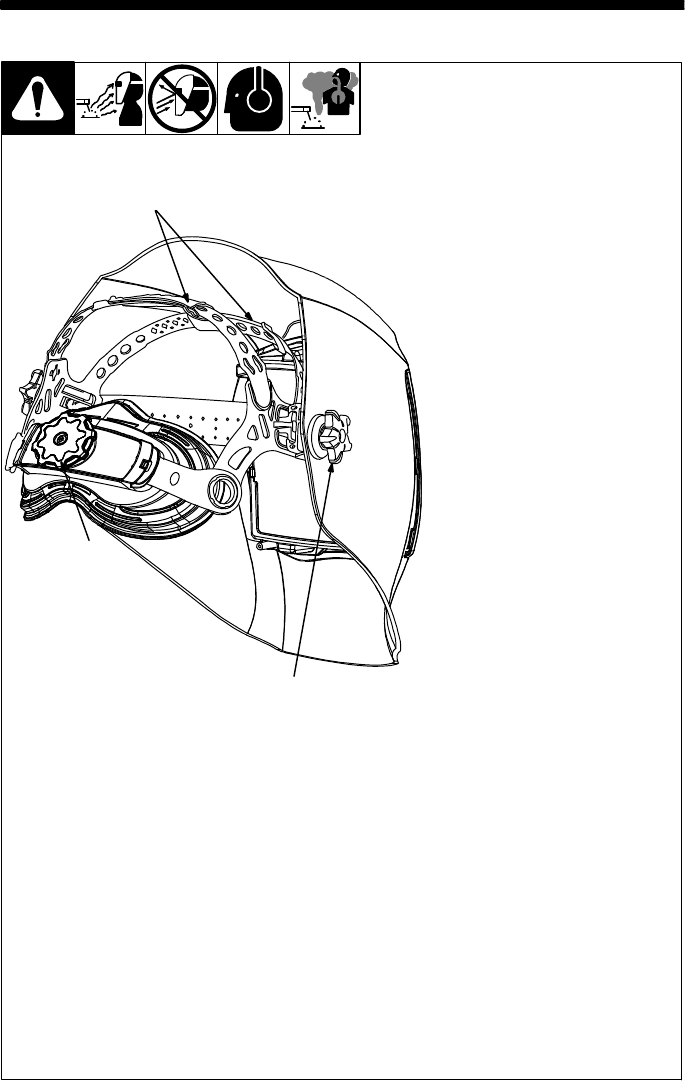
OM-269 681 Page 19
SECTION 4 − ADJUSTING HEADGEAR
4-1. Adjusting Headgear
There are four headgear
adjustments: headgear
top, tightness, angle,
and distance.
1 Headgear Top
Adjusts headgear for proper
depth on the head to ensure
correct balance and stability.
2 Headgear Tightness
To adjust, turn the adjusting
knob located on the back of
the headgear left or right to
desired tightness.
3 Angle Adjustment (Not
Shown)
Seven slots on the right side
of the headband provide ad-
justment for the forward tilt of
the helmet. To adjust, lift and
reposition the control arm to
the desired position.
4 Distance Adjustment
Adjusts the distance be-
tween the face and the lens.
To adjust, press black tabs
on the top and bottom of the
pivot point and use other
hand to slide headgear for-
ward or backward. Release
tabs. (Both sides must be
equally positioned for proper
vision.)
Numbers on the adjust-
ment slides indicate set
position so both sides
can be adjusted equally.
1
2
4

OM-269 681 Page 20
SECTION 5 − REPLACING THE GRINDING SHIELD
OR LENS COVERS
5-1. Replacing Lens Covers
! Never use the auto-darkening
lens without the inside and
outside lens covers properly
installed. Welding spatter will
damage the auto-darkening
lens and void the warranty.
Outside Lens Cover
1 Lens Holder
2 Lens Holder Release Points
3 Outside Lens Cover
Remove lens holder by pulling the
holder away from the helmet in either
bottom corner.
Remove lens cover from shell by
pulling top center of lens. Replace
lens cover in lens holder by placing
one edge in place, bending lens cov-
er, and inserting opposite edge into
lens holder channel. Reinstall lens
holder in helmet.
Inside Lens Cover
4 Auto-Darkening Lens
5 Inside Lens Cover
Remove the inside lens cover by
pulling top center of lens cover from
lens holding channels.
Replace the lens cover by gently
bowing it in the center and inserting
it, one end at a time, into the lens
holding channels.
Be sure the cover lens is seated
properly to prevent fogging.
Auto-Darkening Lens
6 Lens Release Tabs
Remove lens holder and outside
lens cover using instructions above.
Press down on both lens release
tabs and push auto-darkening lens
assembly from the inside to remove.
Replace the lens by aligning it on the
release tabs and pressing it in until it
snaps into place.
804 814 / 804 816 / OTOS
1
2
2
3
4
5
6

OM-269 681 Page 21
SECTION 6 − REPLACING THE BATTERY
(AUTO-DARKENING LENS ASSEMBLIES)
6-1. Replacing The Batteries
1
Be sure Positive (+)
side of battery
faces up.
To replace the batteries, re-
move the auto-darkening lens
assembly (see Section 5).
1 Battery Tray
After removing the lens as-
sembly, slide the battery
holding trays out and remove
the old batteries.
Replace with CR2450 lithium
type batteries (2 required) or
equivalent (Miller Part No.
217 043).
Be sure Positive (+) side
of the battery faces up
(toward inside of hel-
met).
Reinstall the battery trays. To
test battery, press the Auto
On/Off button. The display
screen should turn On. Rein-
stall the lens assembly.

OM-269 681 Page 22
SECTION 7 − INSTALLING OPTIONAL MAGNIFYING
LENS
1 Optional Magnifying Lens
2 Magnifying Lens Adapter
Frame
To install optional magnifying lens,
a magnifying lens adapter frame is
necessary.
Install adapter by placing it
toward the top of the lens
and then sliding the adapter
down until it snaps into
place.
Raised arrows and LOCK/
UNLOCK text show proper
direction.
Once the adapter is in-
stalled, insert the magnify-
ing lens in the top and slide
down to desired position.
Reverse procedure to re-
move magnifying lens. Lift
adapter frame out one edge
at a time.
To prevent lens fogging, install
flat side of magnifying lens to-
ward auto-darkening lens.
804 818
1
2
SECTION 8 − MAINTENANCE
NOTICE − Never use solvents or abrasive cleaning detergents.
NOTICE − Do not immerse the lens assembly in water.
The helmet requires little maintenance. However, for best performance clean after each use. Using
a soft cloth dampened with a mild soap and water solution, wipe the cover lenses clean. Allow to air
dry. Occasionally, the filter lens and sensors should be cleaned by gently wiping with a soft, dry cloth.

OM-269 681 Page 23
SECTION 9 − TROUBLESHOOTING
Trouble Remedy
Auto lens not On – auto-
lens will not darken.
Check batteries and verify they are in good condition and installed
properly.
Check battery surfaces and contacts and clean if necessary.
Check battery for proper contact and gently adjust contact points
if necessary. This is particularly important if the helmet has been
dropped.
Not switching – auto-lens
stays light and will not
darken when welding.
Stop welding immediately: Press the Auto On/Off button.
If power is On, review the sensitivity recommendations and adjust
sensitivity.
Clean lens cover and sensors of any obstructions. Make sure the
sensors are facing the arc; angles of 45 or more may not allow
the arc light to reach the sensors.
Not Switching – auto-lens
stays dark after the weld
arc is extinguished, or the
auto-lens stays dark when
no arc is present.
Fine-tune the sensitivity setting in small increments. In extreme
light conditions, it may be necessary to reduce the surrounding
light levels.
Sections of the auto-lens
are not going dark, distinct
lines separate the light and
dark areas.
Stop welding immediately: The auto-lens may be cracked which
can be caused by the impact of dropping the helmet.
Weld spatter on the auto lens may also cause cracking. (The lens
may need to be replaced; most cracked lenses are not covered by
warranty).
Switching or Flickering –
the auto-lens darkens then
lightens while the welding
arc is present.
Review the sensitivity setting recommendations and increase the
sensitivity if possible. Be sure the arc sensors are not being
blocked from direct access to the arc light.
Check the lens cover for dirt and spatter that may be blocking the
arc sensors. Increasing Lens Delay 0.1 − 0.3 second may also
reduce switching.
Inconsistent or lighter
auto-lens shading in the
dark-state, noticeable on
the outside edges and
corners.
Referred to as an angle of view effect, auto-darkening lenses
have an optimum viewing angle.
The optimum viewing angle is perpendicular or 90 to the surface
of the auto-lens. When that angle of view varies in the dark-state,
welders may notice slightly lighter areas at the outside edges and
the corners of the lens. This is normal and does not represent any
health or safety hazard.
This effect may also be more noticeable in applications where
magnifying lenses are used.

OM-269 681 Page 24
SECTION 10 − PARTS LIST
1
2
3
4
5
10
11
13
6
7
8
12
9
Figure 10-1. Infinity Auto-Darkening Welding Helmet

OM-269 681 Page 25
Description
Part
No.
Item
No. Quantity
Figure 10-1. Infinity Auto-Darkening Welding Helmet
1 271335 Shell, Helmet Black (Infinity) 1............ ......... .......................
1 271336 Shell, Helmet Stars & Stripes (Infinity) 1............ ......... ...............
1 271337 Shell, Helmet Camo (Infinity) 1............ ......... .......................
1 271339 Shell, Helmet Departed (Infinity) 1............ ......... ....................
2 271319 Lens Cover, Inside 4−3/4 in X 3-1/4 in (Inf) 1............ ......... ...........
3 271321 Lens Assembly, Auto-Darkening (Infinity) 1............ ......... ............
4 271320 Lens Cover, Front 6 in X 5-5/8 in (Inf) 1............ ......... ................
5 271322 Holder, Front Lens (Black) (Infinity) 1............ ......... .................
5 271323 Holder, Front Lens (Silver) (Infinity) 1............ ......... .................
5 271324 Holder, Front Lens (Camo) (Infinity) 1............ ......... .................
6 271325 Headgear, Gray (Gen III) (Includes) 1............ ......... .................
7 *256178 Kit, Adjustment Angle/Stop Hardware 1............ .......... .............
8 770249 Headband, Fabric 1............ ........... ..............................
9 ♦271326 Cushion, Top Headgear 1............ ....... ...........................
10 271327 Tray, Battery (Left/Right) (Infinity) 1........... ......... ...................
217043 Battery, Lithium (CR2450) 2.............. ......... .........................
11 770250 Bag, Helmet (Miller Logo) 1........... ......... .........................
12 271328 Adapter, Magnification Lens (XL) 1........... ......... ...................
13 ♦212235 Lens, 0.75 Magnification 1........... ....... ..........................
13 ♦212236 Lens, 1.00 Magnification 1........... ....... ..........................
13 ♦212237 Lens, 1.25 Magnification 1........... ....... ..........................
13 ♦212238 Lens, 1.50 Magnification 1........... ....... ..........................
13 ♦212239 Lens, 1.75 Magnification 1........... ....... ..........................
13 ♦212240 Lens, 2.00 Magnification 1........... ....... ..........................
13 ♦212241 Lens, 2.25 Magnification 1........... ....... ..........................
13 ♦212242 Lens, 2.50 Magnification 1........... ....... ..........................
♦222003 Adapter, Hard Hat 1.............. ....... ................................
♦259637 Adapter, Hard Hat, Slotted QR 1.............. ....... .....................
* Adjustment Hardware Kit With O-rings.
♦Optional
SECTION 11 − LIMITED WARRANTY
LIMITED WARRANTY – Subject to the terms and conditions below. Miller Electric
Mfg. Co., Appleton, Wisconsin, warrants to its original retail purchaser that the new
Miller equipment sold after the effective date of this limited warranty is free of defects
in material and workmanship at the time it is shipped by Miller. THIS WARRANTY
IS EXPRESSLY IN LIEU OF ALL OTHER WARRANTIES, EXPRESS OR IMPLIED,
INCLUDING THE WARRANTIES OR MERCHANTABILITY AND FITNESS.
Miller Digital Series auto-darkening lens helmets are warranted for 3 years from the
date of purchase. Proof of purchase is required for warranty transactions so it is
imperative that a copy of the original invoice or sales receipt be retained.
For warranty transactions, contact your Miller Distributor.
Effective January 1, 2015

ORIGINAL INSTRUCTIONS © 2015 Miller Electric Mfg. Co.
Visit our website at
www.MillerWelds.com
®
Miller Electric Mfg. Co.
An Illinois Tool Works Company
1635 West Spencer Street
Appleton, WI 54914 USA
